Related Research Articles

David Herbert Lawrence was an English writer, novelist, poet and essayist. His works reflect on modernity, industrialization, sexuality, emotional health, vitality, spontaneity and instinct. His best known novels—Sons and Lovers, The Rainbow, Women in Love, and Lady Chatterley's Lover—notably concerned gay and lesbian relationships, and were the subject of censorship trials.

A tomboy is a girl who exhibits characteristics or behaviors considered typical of a boy. Common characteristics include wearing masculine clothing and engaging in games and activities that are physical in nature and are considered in some cultures to be unfeminine, or the domain of boys.
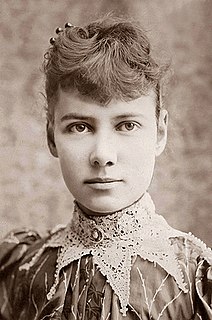
Elizabeth Cochran Seaman, better known by her pen name Nellie Bly, was an American journalist, industrialist, inventor, and charity worker who was widely known for her record-breaking trip around the world in 72 days, in emulation of Jules Verne's fictional character Phileas Fogg, and an exposé in which she worked undercover to report on a mental institution from within. She was a pioneer in her field and launched a new kind of investigative journalism.

Jill Clayburgh was an American actress known for her work in theater, television, and cinema. She received the Cannes Film Festival Award for Best Actress and was nominated for the Academy Award for Best Actress for her breakthrough role in Paul Mazursky's comedy drama An Unmarried Woman (1978). She also received a second consecutive Academy Award nomination for Starting Over (1979) as well as four Golden Globe nominations for her film performances.

Masculinity is a set of attributes, behaviors, and roles associated with men and boys. Masculinity can be theoretically understood as socially constructed, and there is also evidence that some behaviors considered masculine are influenced by both cultural factors and biological factors. To what extent masculinity is biologically or socially influenced is subject to debate. It is distinct from the definition of the biological male sex, as anyone can exhibit masculine traits. Standards of masculinity vary across different cultures and historical periods.

Femininity is a set of attributes, behaviors, and roles generally associated with women and girls. Femininity can be understood as socially constructed, and there is also some evidence that some behaviors considered feminine are influenced by both cultural factors and biological factors. To what extent femininity is biologically or socially influenced is subject to debate. It is conceptually distinct from both the female biological sex and from womanhood, as all humans can exhibit feminine and masculine traits, regardless of sex and gender.
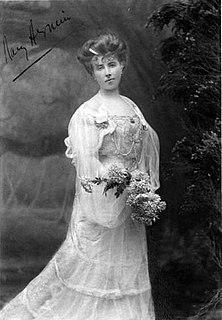
Elizabeth von Arnim, born Mary Annette Beauchamp, was an English novelist.

Belva Ann Bennett Lockwood was an American attorney, politician, educator, and author. She was active in working for women's rights, including women's suffrage. Lockwood overcame many social and personal obstacles related to gender restrictions. After college, she became a teacher and principal, working to equalize pay for women in education. She supported the movement for world peace, and was a proponent of the Temperance movement.
Effeminacy is the embodiment of traits in a boy or man that are more often associated with feminine behavior, mannerism, style, or gender roles rather than with traditionally masculine behavior, mannerisms, style or roles.
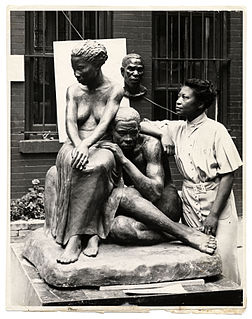
African-American art is a broad term describing visual art created by Americans who also identify as Black. The range of art they have created, and are continuing to create, over more than two centuries is as varied as the artists themselves. Some have drawn on cultural traditions in Africa, and other parts of the world, for inspiration. Others have found inspiration in traditional African-American plastic art forms, including basket weaving, pottery, quilting, woodcarving and painting, all of which are sometimes classified as "handicrafts" or "folk art".
The Dial was an American magazine published intermittently from 1840 to 1929. In its first form, from 1840 to 1844, it served as the chief publication of the Transcendentalists. From the 1880s to 1919 it was revived as a political review and literary criticism magazine. From 1920 to 1929 it was an influential outlet for modernist literature in English.
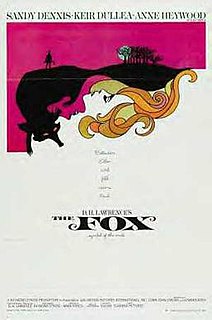
The Fox is a 1967 Canadian drama film directed by Mark Rydell. The screenplay by Lewis John Carlino and Howard Koch is loosely based on the 1923 novella of the same title by D. H. Lawrence. The film marked Rydell's feature film directorial debut.

The Captain's Doll is a short story or novella by the English author D. H. Lawrence. It was written in 1921 and first published by Martin Secker in March 1923 in a volume with The Ladybird and The Fox. It was the basis of the 1983 TV film of the same name with Jeremy Irons as the Captain.

Ellen Wrenshall "Nellie" Grant was the third child and only daughter of U.S. President Ulysses S. Grant and First Lady Julia Grant. At the age of 16, Nellie was sent abroad to England by President Grant, and was received by Queen Victoria. As a teenager growing up in the White House, she attracted much attention.

The Triple Echo is a 1972 British drama film directed by Michael Apted starring Glenda Jackson, Brian Deacon and Oliver Reed, and based on the 1970 novella by H.E. Bates. It was shot in Wiltshire.

Valeria is a pirate and adventuress in the fictional universe of Robert E. Howard's Conan the Barbarian stories. She appears in Robert E. Howard's Conan novella "Red Nails", serialized in Weird Tales 28 1-3. This was the last Conan story written by Howard, and published posthumously. The name was also used for Conan's love interest in the 1982 film Conan the Barbarian.
Boys and Girls is a 1983 Canadian short film directed by Don McBrearty. The film won an Oscar in 1984 for Best Short Subject. Boys and Girls is based on Alice Munro's short story of the same name, written in 1968. It is a coming of age story about a girl growing up on a farm having to accept that in her lifetime she will always be considered "only a girl".

Prey is a 1977 British independent science fiction horror film produced by Terry Marcel and directed by Norman J. Warren. The plot concerns a carnivorous alien landing on Earth and befriending a lesbian couple as part of his mission to evaluate humans as a source of food. It was filmed in under two weeks on a budget of less than £60,000 using locations near Shepperton Studios in Surrey. It had a limited distribution on release.
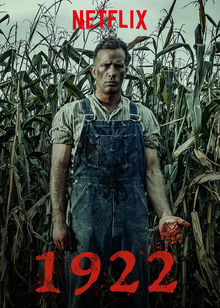
1922 is a 2017 American horror drama film written and directed by Zak Hilditch, based on Stephen King's 2010 novella of the same name. Starring Thomas Jane, Neal McDonough, and Molly Parker, the film was released on Netflix on October 20, 2017.

Sally is an American situation comedy that aired on NBC during the 1957-1958 television season. The series stars Joan Caulfield as Sally Truesdale, a young saleswoman at a department store who tours Europe with a widow who is the store's wealthy and scatter-brained owner. After the trip is over, Sally returns to work at the store.
References
- ↑ "The Fox First Appearance in "The Dial" by Lawrence, D. H.: Near Fine Softcover (1922) First Edition; First Printing. | Good Books In The Woods". www.abebooks.co.uk. Retrieved 23 October 2021.
- ↑ Rydell, Mark (7 February 1968), The Fox (Drama), Motion Pictures International, retrieved 23 October 2021